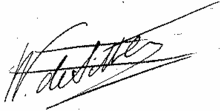Willem de Sitter
Willem de Sitter (born May 6, 1872 in Sneek , † November 20, 1934 in Leiden ) was a Dutch astronomer .
Life
Sitter studied mathematics at the University of Groningen . By Jacobus Kapteyn became interested in astronomy. In 1901 he received his doctorate at Kapteyn with the work Discussion of Heliometer Observations of Jupiter's Satellites . From 1908 he was professor of astronomy at the University of Leiden and in 1925/26 he was rector of the University of Leiden .
In 1913 he published a series of articles in which he showed that the speed of light is independent of the speed of the light source. This confirms the special relativity theory and refutes the emission theory of light.
Sitter's experience in celestial mechanics proved useful in 1916/17 when he described the astronomical consequences of Einstein's general theory of relativity in a series of articles . This work sparked interest in this theory in Great Britain at a time when England's cultural and scientific relations with Germany were severely restricted by World War I, and led directly to Arthur Stanley Eddington's expedition in 1919. From 1919 to 1934 it was he director of the observatory in Leiden.
He maintained acquaintances a. a. to Albert Einstein . On the basis of his theory of relativity , he first described an expanding universe ( de-sitter space ) in 1917 . At that time, however, the De Sitter model was not seen as a dynamic (expanding) model of the universe, but as a stationary solution (there are several representations depending on the choice of coordinates). The “counterpart” to this, the anti-de-sitter room , gained importance in string theory in the 1990s . The De Sitter model was then considered to be a model of a stationary universe and was the dominant cosmological model alongside Einstein's stationary model until the early 1930s. In contrast to the Einstein model, it predicted a redshift effect. Today it is seen as a special case of the (dynamic) Friedmann solutions , with vanishing matter and cosmological constant.
In 1932 he published the so-called Einstein-de-Sitter model , a flat universe with no cosmological term. Both were in California at the time. At the same time, the work stood for the distancing of both Einstein and de Sitter from the cosmological constant, which was no longer necessary with the knowledge of a dynamic, expanding universe.
In 1912 he became a member of the Royal Netherlands Academy of Sciences . From 1925 to 1928 he was President of the International Astronomical Union . In 1929 he was elected to the American Academy of Arts and Sciences and the National Academy of Sciences . In 1931 he was awarded the gold medal of the Royal Astronomical Society and in 1934 with the Jules Janssen Prize . In 1933 he was accepted as a corresponding member of the Académie des sciences .
See also
Fonts
- On the bearing of the Principle of Relativity on Gravitational Astronomy , 1911. In: Monthly Notices of the Royal Astronomical Society , Vol. 71, pp. 388-415
- A proof of the constancy of the velocity of light , 1913. In: Proceedings of the Royal Netherlands Academy of Arts and Sciences , 1913, 15 II, pp. 1297-1298
- An astronomical proof for the constancy of the speed of light , 1913. In: Physikalische Zeitschrift , 14, p. 429
- On the constancy of the velocity of light , 1913. In: Proceedings of the Royal Netherlands Academy of Arts and Sciences , 1913, 16 I, pp. 395-396
- About the accuracy within which the independence of the speed of light from the movement of the source can be asserted , 1913. In: Physikalische Zeitschrift , 14, p. 1267
Web links
- Publications by W. de Sitter in the Astrophysics Data System
- Obituaries for W. de Sitter in the Astrophysics Data System
- John J. O'Connor, Edmund F. Robertson : Willem de Sitter. In: MacTutor History of Mathematics archive .
- Stefan Röhle: Mathematical Problems in the Einstein-De-Sitter Controversy . (PDF; 1.5 MB) MPI Berlin
Individual evidence
- ↑ Willem de Sitter in the Mathematics Genealogy Project (English)
- ^ De Sitter On the relativity of inertia: Remarks concerning Einstein's latest hypothesis . In: Proc. Con. Ned. Acad. Wet. , Volume 19, 1917, pp. 1217-1225. On the curvature of space . In: Proc. Con. Ned. Acad. Wet. , Volume 20, 1917, pp. 229-243. Tullio Levi-Civita independently found these solutions in 1917.
- ^ A. Einstein, W. de Sitter: On the Relation between the Expansion and the Mean Density of the Universe . In: Proceedings of the National Academy of Sciences . tape 18 , no. 3 , March 1932, p. 213-214 , PMC 1076193 (free full text).
| personal data | |
|---|---|
| SURNAME | Sitter, Willem de |
| BRIEF DESCRIPTION | Dutch astronomer |
| DATE OF BIRTH | May 6, 1872 |
| PLACE OF BIRTH | Sneek |
| DATE OF DEATH | November 20, 1934 |
| Place of death | Suffer |

